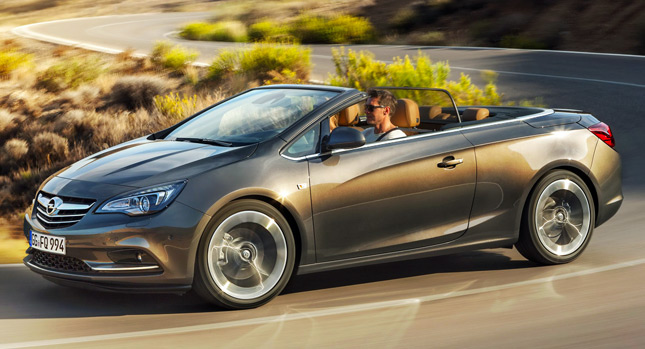Here comes the latest model from Opel and its British counterpart Vauxhall, the all-new Cascada, a mid-size convertible with ample seating for four that was officially revealed today ahead of a European market launch in March of 2013.
The Cascada is the brand’s fourth new model this year following the Ampera, Mokka small crossover and Adam premium city car, and its first convertible after the demise of the smaller Astra Twin Top.
With the Cascada, Opel and Vauxhall are moving away from the compact segment and entering the mid-size sector. At 4,697mm long and 1,840mm wide, the Cascada is not only significantly bigger than the Astra Twin Top, but it’s actually 71mm longer than the Audi A5 Cabrio and 85mm longer than the BMW 3-Series Convertible.
The car uses a platform derived from Astra and Insignia underpinnings sporting a 71mm longer wheelbase and front and rear tracks that are 56mm and 70mm wider respectively than the Astra Twin Top.
The company says that despite being significantly larger, the Cascada’s body is 43 per cent stiffer torsionally and 10 per cent more resistant to bending forces than its last open-topped car.
The Cascada adopts the HiPerStrut front suspension used on the 325PS Insignia VXR, while at the back, there’s a crank beam axle design. All models can be equipped with the company’s FlexRide fully adaptive chassis control system, while wheel options range from 18- to 20-inch in diameters.
While the Astra Twin Top utilized a more sophisticated but costlier and more space intensive metal hardtop, the Cascada gets a traditional soft-top with a triple layer construction for better acoustic and thermal insulation.
The electrically operated hood can be opened in 17 seconds at speeds up to 30mph (48 km/h) by an interior switch, or via a button on the key fob. With the roof down, the Cascada’s boot capacity falls from 350 liters to 280 liters. The top will be available in three colors that can be coordinated with ten different body shades.
“Most convertibles look good with the top down, but many seem clumsy with their roof up. Thanks to its high-quality, aerodynamically clean soft top with a perfect, seamless profile, the Opel Cascada also cuts a fine figure when closed,” said Malcolm Ward, Opel Director of Exterior Design.
Under the bonnet, the big news is the introduction of Opel’s all-new 1.6-liter SIDI Turbo ECOTEC petrol engine that promises to offer notable improvements in torque, linearity and overall efficiency.
In this application, the four-cylinder unit produces a maximum output of 168Hp (170PS) from 1650-3200rpm and 280Nm (206 lb-ft) of torque. Initially, it will be offered only with an automatic six-speed gearbox.
Other powertrain options for the Cascada include an entry level, 1.4-litre turbocharged petrol engine delivering 138hp (140PS) and 220Nm (162 lb-ft), and a 2.0-liter turbo diesel rated for 163Hp (165PS) and 380Nm (280 lb-ft), available with either six-speed manual or six-speed automatic transmissions.
Opel and Vauxhall said that more powerful versions of both petrol and diesel engines will be launched “in due course”.
The interior and exterior styling of the Cascada borrow elements from both the latest iterations of the Astra and Insignia, with the automaker providing several luxury amenities and tech goodies on the standard and optional equipment lists.
Vauxhall said that pricing for the Cascada will start in the UK from around £25,000 (equal to €30,800 or $40,500 at the current exchange rates), or about the same as the entry level BMW 118i Convertible.
“The midsize cabriolet segment is only occupied by very high-priced cars from premium manufacturers,” commented Thomas Sedran, Deputy Chairman of Opel. “With the Cascada, Opel offers all the typical features and premium qualities of a midsize convertible, but at an affordable price.”






















